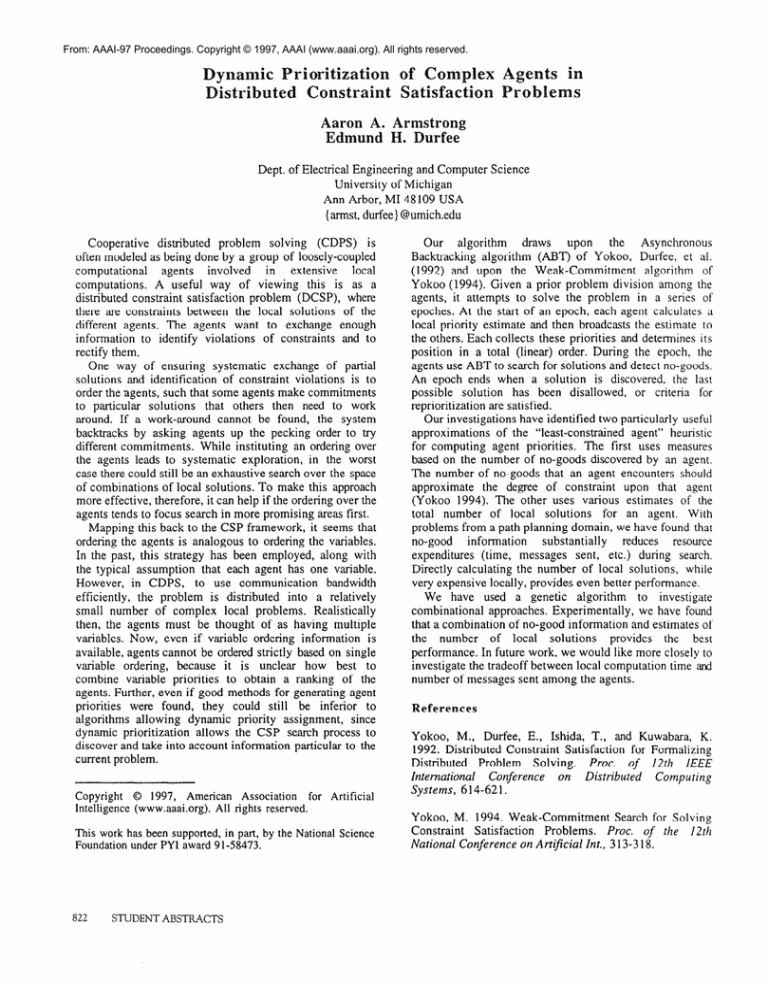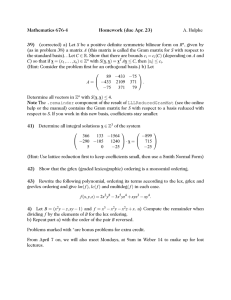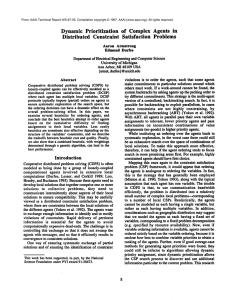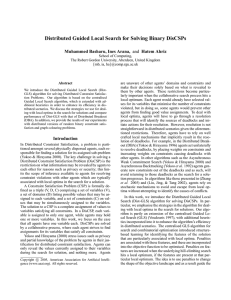
From: AAAI-97 Proceedings. Copyright © 1997, AAAI (www.aaai.org). All rights reserved.
riwitization
t
Qf
co
k!X
Satisfaction
Aaron A. Armstrong
Dept. of Electrical Engineering and Computer Science
University of Michigan
Ann Arbor, MI 48109 USA
{ armst, durfee} @umich.edu
Cooperative distributed problem solving (CDPS) is
often modeled as being done by a group of loosely-coupled
agents
involved
in
extensive
local
computational
computations.
A useful way of viewing this is as a
distributed constraint satisfaction problem (DCSP), where
there are constraints between the local solutions of the
different agents. The agents want to exchange enough
information to identify violations of constraints and to
rectify them.
One way of ensuring systematic exchange of partial
solutions and identification of constraint violations is to
order the agents, such that some agents make commitments
to particular solutions
that others then need to work
around. If a work-around cannot be found, the system
backtracks by asking agents up the pecking order to try
different commitments.
While instituting an ordering over
the agents leads to systematic exploration, in the worst
case there could still be an exhaustive search over the space
of combinations of local solutions. To make this approach
more effective, therefore, it can help if the ordering over the
agents tends to focus search in more promising areas first.
Mapping this back to the CSP framework, it seems that
ordering the agents is analogous to ordering the variables.
In the past, this strategy has been employed, along with
the typical assumption that each agent has one variable.
However, in CDPS, to use communication
bandwidth
efficiently, the problem is distributed into a relatively
small number of complex local problems. Realistically
then, the agents must be thought of as having multiple
variables. Now, even if variable ordering information is
available, agents cannot be ordered strictly based on single
variable ordering, because it is unclear how best to
combine variable priorities to obtain a ranking of the
agents. Further, even if good methods for generating agent
priorities were found, they could still be inferior to
algorithms allowing dynamic priority assignment, since
dynamic prioritization allows the CSP search process to
discover and take into account information particular to the
current problem.
Copyright 0 1997, American Association for Artificial
Intelligence (www.aaai.org). All rights reserved.
This work has been supported,
in part, by the National Science
Foundation under PYI award 91-58473.
822
STUDENT ABSTRACTS
Our
algorithm
draws
upon
the
Asynchronous
Backtracking algorithm (ABT) of Yokoo, Durfee, et al.
(1992) and upon the Weak-Commitment
algorithm of
Yokoo (1994). Given a prior problem division among the
agents, it attempts to solve the problem in a series of
epoches. At the start of an epoch, each agent calculates a
local priority estimate and then broadcasts the estimate to
the others. Each collects these priorities and determines its
position in a total (linear) order. During the epoch, the
agents use ABT to search for solutions and detect no-goods.
An epoch ends when a solution is discovered, the last
possible solution has been disallowed, or criteria for
reprioritization are satisfied.
Our investigations have identified two particularly useful
approximations
of the “least-constrained
agent” heuristic
for computing agent priorities. The first uses measures
based on the number of no-goods discovered by an agent.
The number of no-goods that an agent encounters should
approximate the degree of constraint upon that agent
(Yokoo 1994). The other uses various estimates of the
total number of local solutions
for an agent. With
problems from a path planning domain, we have found that
no-good
information
substantially
reduces resource
expenditures (time, messages sent, etc.) during search.
Directly calculating the number of local solutions, while
very expensive locally, provides even better performance.
We have used a genetic algorithm
to investigate
combinational approaches. Experimentally,
we have found
that a combination of no-good information and estimates of
the number
of local solutions
provides the best
performance. In future work, we would like more closely to
investigate the tradeoff between local computation time and
number of messages sent among the agents.
References
Yokoo, M., Durfee, E., Ishida, T., and Kuwabara, K.
1992. Distributed Constraint Satisfaction for Formalizing
Distributed
Problem
Solving.
Proc. of 12th IEEE
International
Conference
on Distributed
Computing
Systems, 6 14-62 1.
Yokoo, M. 1994. Weak-Commitment
Search for Solving
Constraint
Satisfaction
Problems.
Proc. of the 12th
National Conference on Arti’cial Int., 3 13-3 18.





